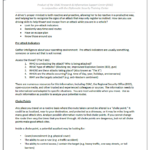
A driver’s proper mindset is both reactive and proactive, allowing her to be reactive in a productive way, and helping her to recognize the signs of an attack that may only register as instinct.
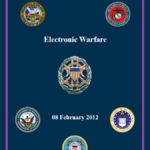
All modern forces depend on the electromagnetic spectrum (EMS). The military requirement for unimpeded access to, and use of, the EMS is the key focus for joint electromagnetic spectrum operations (JEMSO), both in support of military operations and as the focus of operations themselves. Electronic warfare (EW) is essential for protecting friendly operations and denying adversary operations within the EMS throughout the operational environment.
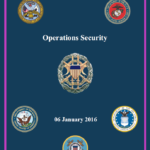
Commanders ensure operational security (OPSEC) is practiced during all phases of operations. OPSEC is a capability that identifies and controls critical information, indicators of friendly force actions attendant to military operations, and incorporates countermeasures to reduce the risk of an adversary exploiting vulnerabilities. As adversary analysts apply more information to an analytical model, the likelihood increases that the analytical model will replicate the observed force. Thus, current and future capabilities and courses of action can be revealed and compromised.
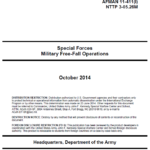
DODD 5100.01 tasks the Army to “train and equip, as required, forces for airborne operations, in coordination with the other military Services, and in accordance with joint doctrine.” This guidance directs the Army, which has primary responsibility for the development of airborne doctrine, procedures, and techniques, to develop, in coordination with the other military Services, doctrine, procedures, and equipment that are of common interest.
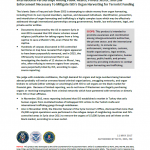
The Islamic State of Iraq and ash-Sham (ISIS) is attempting to obtain money from organ harvesting, including from its own injured members, captives, and deceased individuals. Identification, prevention, and interdiction of organ harvesting and trafficking is a highly complex issue which may be effectively addressed through international partnerships among governmental, health, law enforcement, legal, and private-sector entities.
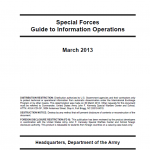
This TC serves as a guide to describe the fundamentals of how to incorporate IO at the tactical and operational level. Appendixes A through F offer tactics, techniques, and procedures (TTP) Special Forces (SF) Soldiers can use to analyze and plan information operations. This TC implements Army and joint IO doctrine established in FM 3-13, Inform and Influence Activities, and Joint Publication (JP) 3-13, Information Operations. This TC reinforces the definition of IO used by Army forces: IO employs the core capabilities of electronic warfare (EW), computer network operations (CNO), Military Information Support operations (MISO), military deception (MILDEC), and operations security (OPSEC), in concert with specified supporting and related capabilities, to affect or defend information and information systems and to influence decisionmaking. This TC is specifically targeted for SF; however, it is also useful to Army special operations forces (ARSOF) and the Army in understanding how SF employs IO.
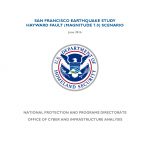
The results of this analysis show a strong earthquake will likely cause significant damage to critical infrastructure in the area affecting 547 dams or water control structures, render approximately 300 roadway segments unusable, and cause damage to 172 water and wastewater treatment systems. The scenario earthquake will likely cause damage to 154 dams in the area. Seven of the dams will likely experience Extensive or Complete damage. The Ward Creek Dam, which is used for flood control, is likely to incur Complete damage. Extensive damage to the James H. Turner Dam poses the greatest risk to downstream population. The earthquake will cause damages to many road segments, bridges, and tunnels in the area. As a result, travel times on these roadways and others will increase significantly. Multiple areas on freeways such as I–680, I–880, and I–580 will have the highest above normal traffic volumes. Several bridges on these freeways will also likely incur Extensive damage. Tunnels in the area will likely have less damage with bores in the Caldecott Tunnel on State Route 24 experiencing only Moderate damage.
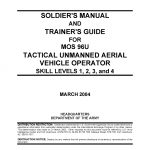
This manual identifies the individual MOS training requirements for soldiers in MOS 96U. Commanders, trainers, and soldiers should use it to plan, conduct, and evaluate individual training in their unit. This manual is the primary MOS reference to support the self-development and training of every 96U soldier.
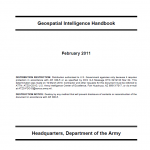
This training circular provides GEOINT guidance for commanders, staffs, trainers, engineers, and military intelligence personnel at all echelons. It forms the foundation for GEOINT doctrine development. It also serves as a reference for personnel who are developing doctrine; tactics, techniques, and procedures; materiel and force structure; and institutional and unit training for intelligence operations.
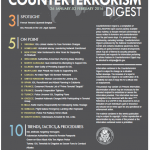
Counterterrorism Digest is a compilation of UNCLASSIFIED open source publicly available press material, to include relevant commentary on issues related to terrorism and counterterrorism over the past seven days. It is produced every Wednesday, excluding holidays. Counterterrorism Digest is produced by the National Counterterrorism Center and contains situational awareness items detailing on-going terrorism-related developments which may be of interest to security personnel.
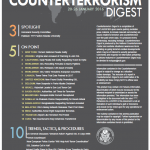
Counterterrorism Digest is a compilation of UNCLASSIFIED open source publicly available press material, to include relevant commentary on issues related to terrorism and counterterrorism over the past seven days. It is produced every Wednesday, excluding holidays. Counterterrorism Digest is produced by the National Counterterrorism Center and contains situational awareness items detailing on-going terrorism-related developments which may be of interest to security personnel.
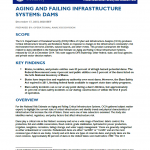
Dam safety incidents can occur at any point during a dam’s lifetime, but the most common period of dam failure is the first 5 years of operation. The United States Society of Dams conducted a study in 2009 of 1,158 national and international dam failures and safety incidents and found that 31 percent of safety incidents occur during construction or within the first 5 years of operation. The most common causes of failure are overtopping, piping, and foundation defects. Overtopping caused by flooding and high-water events accounts for 34 percent of dam failures in the United States. Erosion caused by overtopping can compromise embankments and lead to failure. The risk of overtopping increases if the spillway design is inadequate, debris causes spillway blockage, or the dam crest settles.
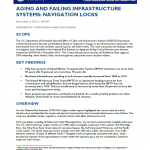
Most locks are designed to last for 50 years, but 54 percent of IMTS locks are more than 50 years old, and 36 percent are more than 70 years old. Many of these locks are in need of repair and replacement, and some lack basic maintenance. Concrete is crumbling at some locks, and some have not been painted in 25–30 years, increasing the risk of corrosion. Locks lacking maintenance or in need of repair and replacement are more likely to have unscheduled closures. Unscheduled closures are more costly than scheduled closures, because vessel operators and companies are unable to plan to offset the delays from these incidents. The annual number of unscheduled lock closures has steadily increased since 1992. Fewer than 7,000 unscheduled closures occurred every year before 2000, and more than 7,000 occurred every year after 2000, peaking in 2008 with 13,250.
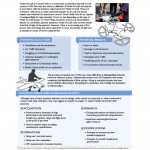
Model Aircraft are custom built or commercially produced unmanned aircraft systems (UAS) that meet the statutory definition of Model Aircraft and operate in accordance with the statutory requirements for Model Aircraft. These are sometimes referred to as radio controlled airplanes or aircraft and usually require one individual for operational control. Some Model Aircraft are capable of sustained flight for approximately 2 hours or less depending on the type of Model Aircraft (Rotary or Fixed Wing) and power source (e.g. nitromethane, lithium ion, and lithium polymer batteries). Model Aircraft must be flown within visual line of sight of the operator; however, there is an increasing use of first person view technology that allows operation to occur beyond line of sight and at altitudes in excess of several hundred feet.
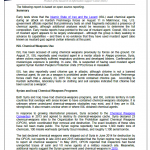
Early tests show that the Islamic State of Iraq and the Levant (ISIL) used chemical agents during an attack on Kurdish Peshmerga forces on August 11 in Makhmour, Iraq. U.S. government officials reported that preliminary tests on shell fragments indicated a presence of chemical agents, although additional analyses would be necessary to determine the full composition. Early media reports have pointed to the use of mustard agent. Overall, ISIL’s use of mustard agent appears to be largely undeveloped – although the group is likely seeking to advance its capabilities – and there is no evidence that they have used mustard agent (also known as mustard gas) against civilian interests at this point.
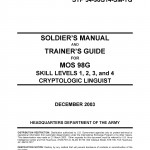
This publication is for soldiers holding military occupation specialty (MOS) 98G and their trainer/first-line supervisor. It contains standardized training objectives in the form of task summaries that support unit missions during wartime. Soldiers holding MOS 98G should be issued or have access to this publication. It should be available in the soldier’s work area, unit learning center, and unit libraries. Trainers and first-line supervisors should actively plan for soldiers to have access to this publication. It is recommended that each 98G soldier be issued an individual copy.
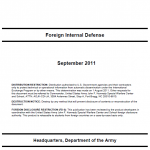
FID is participation by civilian and military agencies of a government in any of the action programs taken by another government or other designated organization to free and protect its society from subversion, lawlessness, insurgency, terrorism, and other threats to its security (Joint Publication [JP] 3-22, Foreign Internal Defense). This publication depicts the integrated theater efforts that include ARSOF and conventional forces roles in joint, multinational, intergovernmental, and nongovernmental organizations working in a collaborative environment. It provides an overview of selected sources of power applied through the instruments of national power brought to bear for supporting FID and the impact and interaction of Army units with the other instruments of national power. In addition, it illustrates how FID is a key component of a host nation’s (HN’s) program of internal defense and development (IDAD), and that the focus of all U.S. FID efforts is to support that IDAD program to build capability and capacity to free and protect the HN from subversion, lawlessness, and insurgency.
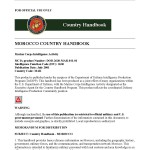
This handbook provides basic reference information on Morocco, including the geography, history, government, military forces, and the communications, and transportation network Morocco. This information is intended to familiarize military personnel with local customs and area knowledge in an effort to assist them during their assignment to Morocco.
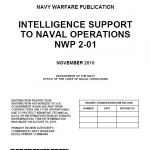
NWP 2-01 is a comprehensive reference detailing the intelligence support available to the naval commander in the successful planning and execution of operations. NWP 2-01 is by nature a refresher and ready resource for the Information Dominance Corps (IDC) intelligence professionals, information warfare officers, and cryptologic technicians; however, the target audience is the operational commander. The publication’s length and content are specifically tailored to ensure a practical and valuable reference for the operational decision maker. NWP 2-01 is the foundation for a series of proposed follow-on Navy tactics, techniques, and procedures (NTTP) publications.
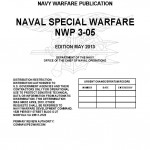
This navy warfare publication describes the nature, forces, organization, and employment of naval special warfare (NSW). Naval special warfare is a relatively small, maritime special operations force (SOF) consisting of approximately 9,250 personnel: 2,700 sea-air-land commandos (SEALS), 700 special warfare combatant-craft crewmen (SWCCs), 750 Reservists, 4,000 combat support (CS) and combat service support (CSS) personnel, and more than 1,100 civilians. NSW constitutes 11 percent of special operations forces and less than 2 percent of United States Navy (USN) forces. NSW costs 3/10ths of one cent (0.3 percent) of every United States (U.S.) defense dollar.
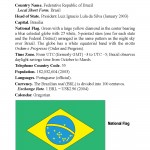
This handbook provides basic reference information on Brazil, including its geography, history, government, military forces, and communications and transportation networks. This information is intended to familiarize military personnel with local customs and area knowledge to assist them during their assignment to Brazil.
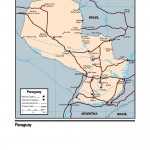
This handbook provides basic reference information on Paraguay, including its geography, history, government, military forces, and communications and transportation networks. This information is intended to familiarize military personnel with local customs and area knowledge to assist them during their assignment to Paraguay.